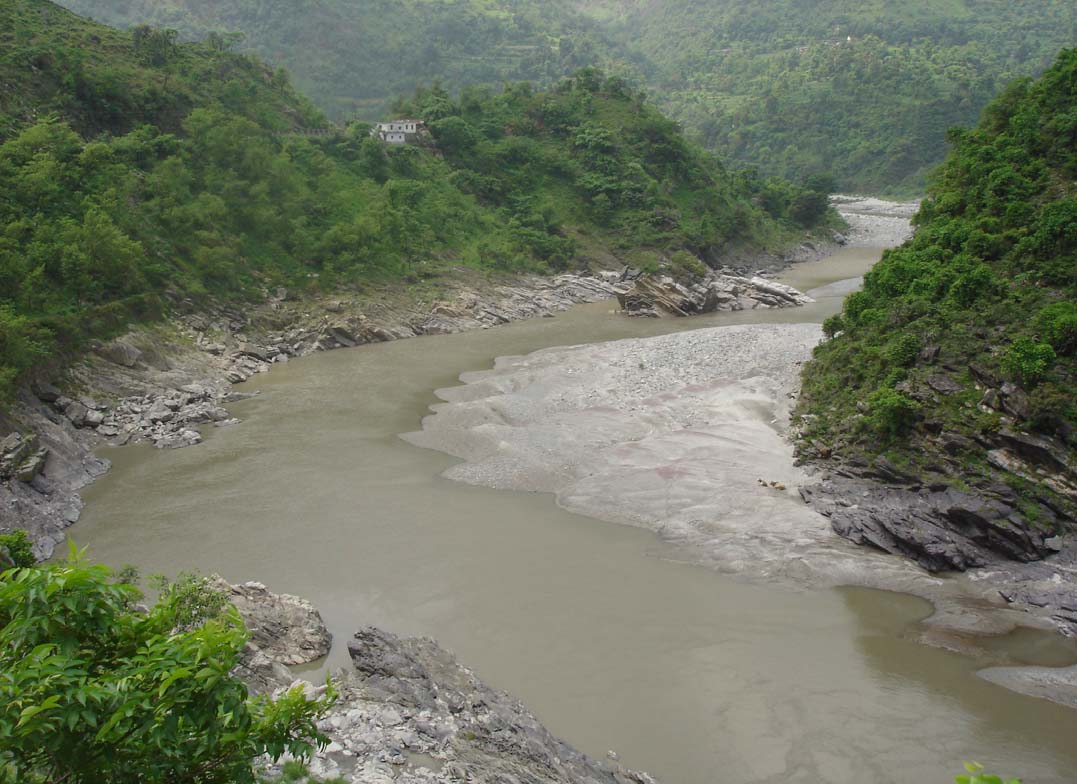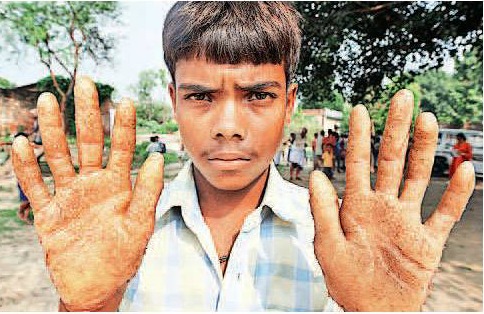Arsenic was a very rarely heard term in the water sector till a few decades back. However, in recent years, the number of areas reporting arsenic contamination have gone up drastically with over 20 countries from different parts of the world reporting arsenic contamination of groundwater (Bordoloi, 2012). With the constantly increasing number of occurrences, especially in the South Asian region, it is now recognized as a major public health concern affecting a large number of people around the world.
In South Asia, arsenic contamination in groundwater in the Ganga- Brahmaputra fluvial plains in India and Padma-Meghna fluvial plains in Bangladesh has been found to have a huge impact on human health and its consequences have been reported as the world’s biggest natural groundwater calamities. In India, West Bengal, Jharkhand, Bihar, Uttar Pradesh in the flood plains of the Ganga, Assam and Manipur in the flood plains of the Brahamaputra and Imphal rivers and Rajnandgaon village in Chhattisgarh state have been reported to be affected by arsenic contamination in groundwater (Ghosh and Singh, nd)
What is arsenic?
Arsenic (As) is an odourless and tasteless metalloid widely distributed in the earth’s crust. Elemental arsenic is a member of Group VA of the periodic table, with nitrogen, phosphorus, antimony and bismuth. It has an atomic number of 33 and an atomic mass of 74.91.
What are the forms of arsenic available in nature?
Arsenic and its compounds occur in crystalline, powder, amorphous or vitreous forms. It usually occurs in trace quantities in all rocks, soil, water and air. It is the 26th abundant element in the earth's crust.
Which form of arsenic is the most toxic?
Arsenite [As (III)] is most toxic form of arsenic and causes acute toxicity. Forms of arsenic such as As (III) and As (V) lead to chronic toxicity. Previously it was thought that methylated forms of arsenic [MMA (V), DMA (V)] were less toxic. However, current studies indicate that these two forms of arsenic are highly toxic.
What are the different exposure sources of arsenic?The exposure sources of arsenic in the environment include natural and anthropogenic sources:
Natural – Leaching of ambient arsenic in groundwater from sediments containing arsenic bearing minerals; leaching and percolation of arsenic in soils.
Anthropogenic – Agrochemicals, wood preservatives, industrial sources, mineral processing, acid mine drainage, burning of fossil fuels etc.
How does arsenic enter the human body?
Arsenic can get into the human body through drinking water as well as eating food that has been contaminated with arsenic
How does arsenic get into drinking water?
Because it occurs naturally in the environment and as a by-product of some agricultural and industrial activities, it can enter drinking water through the ground or as runoff into surface water sources.
How does arsenic become a part of the food cycle?
When agricultural fields are irrigated with arsenic contaminated groundwater, inorganic forms of arsenic get absorbed by the plants and hence arsenic enters the food cycle.
Is arsenic always harmful in food?
Arsenic present in inorganic forms as arsenite and arsenate is toxic. However, organic forms of arsenic like arsenobetaine, arsenocholine, arsenosugar, are non-toxic (these forms are mainly present in sea foods).
What happens to the arsenic that gets inside the human body?
Arsenic in drinking water is absorbed through the intestine into the bloodstream through which it reaches the various organs. The human body normally gets rid of smaller amounts of arsenic through urine. However, if there are large amounts of arsenic, the remaining arsenic accumulates inside the body and can lead to adverse health effects. However, the mechanisms underlying the adverse health effects by arsenic are not completely known. The level of accumulated arsenic can be known by investigating nail and hair samples.
What is Arsenicosis?
Arsenicosis is the medical word for arsenic poisoning, which occurs due to accumulation of large amounts of arsenic in the body.
Arsenicosis leads to adverse health effects through inhibition of essential enzymes, which ultimately leads to death from multi-system organ failure.
What are the health effects of arsenic poisoning?
Arsenic causes or increases the risk of numerous illnesses. It leads to skin damage including keratosis and skin cancer, internal cancers such as that of the lung and bladder, and diseases of the vascular system. Other health problems, such as diabetes, cancers of the other organs and adverse reproductive outcomes have been observed, but the evidence is not yet conclusive, although it keeps increasing.
What is the accepted standard of arsenic concentration in drinking water?
The guideline value or maximum contaminant level (MCL) for arsenic in drinking water is 10 ppb (according to WHO) followed by most of the developed countries. In developing countries including India and Bangladesh, 50 ppb is considered as the accepted level for arsenic in drinking water.
How much exposure to arsenic contaminated water is expected to result in skin lesions?
Evidence from the field has indicated that people drinking arsenic contaminated water for a couple of years may show arsenical skin lesions. The risk has been found to be more among people who are exposed to water contaminted with arsenic above levels of 500 μg/l . However, studies also indicate that even when exposed to a similar risk, all individuals do not display symptoms of skin lesions. The exact reason for this is not yet known.
Can one use surface water and rainwater and dugwell water as an arsenic free drinking water source? How?
These sources can be used for drinking after proper treatment against bacterial contamination and other toxins. Most of the dugwells are arsenic safe, but some of the dugwells could be contaminated with arsenic. Surface water is not usually contaminated with arsenic.
Does boiling remove arsenic from water?
No, arsenic cannot be removed by boiling as it is not a volatile substance. Rather, its concentration increases as water evaporates during boiling.
Is arsenicosis contagious?
No, it is not contagious.
How can one know if their tubewell is arsenic contaminated?
Arsenic has no distinctive taste, colour and odour. After proper collection and preservation, the water sample has to be analyzed for arsenic from an authorized analytical laboratory. Certified field kits can also serve the purpose, but these kits are only indicative in nature and not conclusive.
What are the biomarkers of arsenic?
Hair, nails, urine and skin scales of the person consuming arsenic contaminated water.
Are results based on field kit analysis a reliable method to assess the presence of arsenic in water?
Field kit analysis results may be accepted as an indicative result and may be conclusively accepted only after verification with laboratory procedures of testing. In the past, it has been observed that field kit analysis results have often turned out to be inaccurate.
Can arsenic affect an unborn child?
Although there is no evidence that arsenic can harm pregnant women or their fetuses, studies in animals have shown that doses of arsenic that are large enough to cause illness in pregnant females may cause low birth weight, fetal malformations, or fetal death.
| The Arsenic Knowledge Network |
|---|
|
What is the Arsenic Network? The Network is an attempt to create a repository of knowledge in arsenic studies across South Asia and enable action based on this knowledge, towards addressing the issue on ground by supporting coordinated efforts for arsenic mitigation. To join the network, please mail us at contact@indiawaterportal.org. |







 The issue was examined by CAG because various stakeholders working in the field of environment flagged water pollution as the most important environmental issue that concerns us.
The issue was examined by CAG because various stakeholders working in the field of environment flagged water pollution as the most important environmental issue that concerns us. 
 It evolves a methodology for identifying hot spots in Indian rivers. The water quality data is based on the average values observed during the last ten years (2001-2011) at 371 monitoring stations of CWC on almost all major, medium and minor rivers in India. In respect of Dissolved Oxygen and Biochemical Oxygen Demand, the
It evolves a methodology for identifying hot spots in Indian rivers. The water quality data is based on the average values observed during the last ten years (2001-2011) at 371 monitoring stations of CWC on almost all major, medium and minor rivers in India. In respect of Dissolved Oxygen and Biochemical Oxygen Demand, the